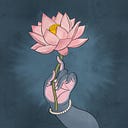Rāgamāla Paintings
German scholar Klaus Ebeling studied Rāgamāla paintings extensively and wrote the text of the same name. He regards them as visual interpretations of musical “modes” or rāgas, previously envisioned in divine or human form by musicians and poets. They show most frequently romantic or devotional situations in a somewhat stereotyped, aristocratic setting. Rāgamāla, or a “garland of rāgas”, are a series of paintings that were created in albums containing most often thirty-six or forty-two folios, organized in a system of “families”. Each “family” is headed by a (male) Raga and contains five or six Rāgiṇi (wives), sometimes also several Rāgaputras (sons), even Rāga-putris (daughters), and wives of sons. All known surviving examples of this art were painted in the 16th through I9th centuries in Rajasthan, in Central India, in the Deccan, in the Ganges-Jamuna delta, or in the Pahari region.
The rāgas in question are those belonging to the Hindustani system of classical music. A general definition of Rāga by an eighteenth century musicologist is as follows: “Those are called rāgas by Bharata and other sages by which the hearts of all the beings in the three worlds are colored and pleased.” Thus, the word is derived from the root rañja meaning “to color” or “to tinge.” The word color is clearly used to characterize music which is pleasing to the ear. A secondary meaning of the word Rāga is “passion”, as it came to be associated with human feelings and emotions.
Though the religious connections and themes are not immediately apparent, rāgamāla series of miniature paintings represent a synesthetic merging of poetry, music, and painting that developed from Hindu temple practice, in which architecture, painting, sculpture, and literature, as well as music, dance, and costume, were combined to honor deities.
Rāgamāla paintings stand at the crossroads of Indian miniature painting, music, and poetic traditions. They served as memorization devices for musicians, poets were fascinated with the deification of rāgas, and women of aristocratic households seemed to be most taken with their themes of longing, love, love union, and other subjects. Each Rāga or Rāgiṇi is defined not only in strictly technical musical terms, but equally importantly in spiritual and emotional terms. Thus, each expresses or evokes a particular mood or evokes a particular rasa — devotion, tranquility, loneliness, heroism, eroticism, etc. — as well evoking a specific season and a time of day or night. It has, as Coomaraswamy has suggested, its own characteristic ethos.
It is almost unanimously agreed that the Vasanta Rāga or Rāgiṇi, as its name implies, is associated with spring and was perhaps a melody sung at a spring festival. Since Holi (or the festival of colors) is the major spring festival in India, the Vasanta Rāga naturally comes to be associated with Holi. Moreover, Holi is a predominantly Vaiṣṇava festival and so the Rāga is also dedicated to the Vaiṣṇava god Krṣṇa.
Similarly, Tōḍi Rāgiṇi in Rajasthan is generally depicted by a solitary nāyika wandering through the forest playing her vīṇa, and attracting deer. In the image below, she is dressed in a gold floral-patterned pajama and choli (bodice), plucking her vīṇa with one hand, charms three male deer and two does in a green forest clearing. She stands amid a spray of mauve stylized rocky outcroppings capped with blossoming trees. Hare and deer listen quietly as a pair of birds fly above in a cloudy blue sky.
Tōḍi Rāgiṇi is a meloncholy Rāgiṇi, whose paintings reflect the loneliness of the heroine; yet, it is popular with both musicians and painters.
“Divided from her darling and most unhappy in love,
like a nun renouncing the world,
Tōḍi abides in the grove and charms the hearts of the does”.
(Translation of the inscription adapted by Pratapaditya Pal from A.K. Coomaraswamy)
Vaiṣṇava legends, Purāṇic mythology, and other forms of literature provided endless subject matter for the illustration of the Rāgamāla themes, and in thus depicting human emotions in a divine context, expression was given to the Indian belief that there is no real distinction between the two worlds: that the divine resides within every human being.
Ragamala Painting ceased to be a living art in the 19th century due to the growing influence of Western “civilization”, the decay of the feudal system and its culture, the declining practice of traditional arts in general, and other factors.
References:
- Ragamala paintings in the Museum of Fine Arts, Boston by Pal, Pratapaditya 1967
2. Ebeling, K. (1973). Ragamala Painting. India: Ravi Kumar.
Cornell University Library’s digital Rāgamālā collection consists of around 4000 photographs that were taken by Klaus Ebeling between 1967 and 1972 as he visited museums and private collections all over the world while working on his book Ragamala Painting.
__________________________________________
If you find value in my work, I hope you consider becoming a patron or making a contribution to hindu.aesthetic@okicici. Hindu Aesthetic requires a lot of time and effort and your support would mean that I can continue bringing you the best possible content. ❤
